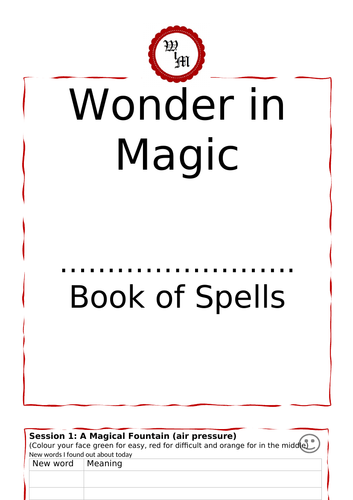





This resource is the first of a set of 4 lesson plans with STEM activities based around a group of 10-12 year olds, wanting to explain the science and maths behind magic.
This first session teaches AIR PRESSURE, a gravitational force.
(Other sessions involve PROBABILITY, CHEMICAL REACTIONS, STATIC ELECTRICITY. )
Wonder in Magic has been created as a teaching resource for the City of Edinburgh Council’s ‘Curiosity Club’, an Intervention Strategy initiative that is currently operating in Council schools. The focus of the four planned lessons of Wonder in Magic is to explain the ‘magic’ behind science and maths activities. This is the first on air pressure, a gravitational force.
The second has an activity on probability. The third involves chemical reactions and the fourth static electricity. There is an optional activity (session 5) on showcasing the knowledge and skills obtained in Wonder in Magic. You can find all of these in our TES Shop for free download and re-use.
The log-book (‘Book of Spells’), general teaching notes, completion certificate and letter (‘hook’) are included with all resources.
This is the first on air pressure, a gravitational force.
This bundle includes: extensive teacher notes bundle includes PDF and editable versions of the following:
Air Pressure – A Magical Fountain - contents for each lesson includes:
- Resource list
- Learning Intentions
- Shared success criteria
- Relevant Es&Os
- Assessment Methods
- Lesson Plan
General resources
- ‘Hook’ letter from the Head Teacher of Scotland’s Magic School
- Log-book (aka Book of Spells)
- Completion Certificate
- General Teaching Notes
Learning outcomes in the Curriculum for Excellence and associated benchmark
SCN 2-08a: I have collaborated in investigations to compare magnetic, electrostatic and gravitational forces and have explored their practical applications.
y investigating how friction, including air resistance, affects motion, I can suggest ways to improve efficiency in moving objects. (Explores and explains air pressure, a gravitational force)
LIT 2-07a: I can show my understanding of what I listen to or watch by responding to literal, inferential, evaluative and other types of questions, and by asking different kinds of questions of my own. (Asks and responds to a range of questions, including literal, inferential and evaluative questions, to demonstrate understanding of spoken texts.)
This resource was created as part of the GeoScience Outreach Course, which is a 4th year undergraduate course in the School of GeoSciences aiming to provide students with the opportunity to develop their own science communication and engagement project.
To find more Open Educational Resources from the University of Edinburgh, visit open.ed.ac.uk.
Author: Philippa Johnston, adapted by Kay Douglas and Charlie Farley.
Unless otherwise stated, all content is released under a CC-BY-SA 4.0 license.
Something went wrong, please try again later.
This resource hasn't been reviewed yet
To ensure quality for our reviews, only customers who have downloaded this resource can review it
Report this resourceto let us know if it violates our terms and conditions.
Our customer service team will review your report and will be in touch.